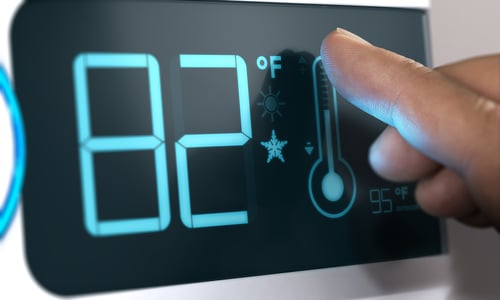Efficient HVAC equipment can drastically reduce a building's electricity and gas bills. However, best performance is only achieved if thermostats are set correctly. Even the most efficient boilers and chillers on the market can underperform with a poorly set thermostat.
A common practice that wastes a lot of energy is setting the thermostat to extreme values – using the lowest temperature on the scale during the summer and the highest temperature in the winter. HVAC engineers do not recommend this practice, since even the most efficient equipment performs poorly at extreme temperature settings.
Improve your HVAC efficiency with automatic controls.
Thermostat Settings and Energy Efficiency
Maintaining a temperature difference between the inside and outside of a building requires energy, and energy demand increases as the temperature difference increases. For example, keeping a room 10°F cooler than the outside air uses less energy than keeping it 15°F colder, and the same logic applies to space heating during the winter.
Extreme thermostat settings not only increase the load on HVAC systems but also reduce a building's overall efficiency. Consider that heat transfer increases when the temperature difference is greater, and this has two negative effects:
- Summer heat gain is greater when the interior of the building is kept cooler.
- Winter heat loss is greater when the interior of the building is kept warmer.
In a nutshell, improper thermostat settings increase the workload on HVAC systems while reducing overall efficiency. Consider that heating and cooling are among the highest energy costs in a building and incorrect use of HVAC equipment can increase them noticeably.

The U.S. Department of Energy recommends a thermostat setting of 68°F during the winter and 78°F during the summer. When there are no occupants in the area, these values can be set back by 7-10°F, considering that “setback” has a different meaning for each mode of operation:
- In the summer, the thermostat should be set 7 to 10°F higher for zero occupancy conditions.
- In winter, it should be set 7 to 10°F lower for zero occupancy.
The average US household can expect energy savings of around 10% by following the recommendations above. With the average household consumption of $900/year reported by the ENERGY STAR program, this translates into a savings of $90/year. If a smart thermostat can be purchased for $250, the payback period will be less than three years.
In New York City, the business landscape for smart thermostats improves with the Con Edison incentive program. Discounts vary depending on the customer's location and project conditions, but in some cases they are high enough to cover the full cost of a smart thermostat.
Difference Between Programmable and Smart Thermostats
The terms “programmable” and “smart” are often used interchangeably when referring to thermostats, but there are important differences. Both thermostat types can control HVAC equipment based on schedules, but smart thermostats can program themselves based on usage habits, while programmable thermostats require initial setup.
Compatibility is a very important aspect when purchasing programmable or smart thermostats.
- Compatibility issues with room cooling systems are rare, as most air conditioners are based on an electrically powered refrigeration cycle.
- On the other hand, some space heating systems can be difficult to integrate with smart thermostats. Many models are designed for gas heating systems and do not integrate well with resistance heaters and heat pumps.
- Radiant heating and steam heating systems can also be difficult to integrate with thermostats due to their slow thermal response.
If you're considering a smart thermostat, HVAC engineers strongly recommend that you look for a product with the ENERGY STAR label. This ensures high performance and eligibility for discount programs available in your location.
Final Recommendations
Smart thermostats are very useful in residential and light commercial applications. However, larger properties require a building automation system (BAS) to control the temperature settings of HVAC equipment. The complexity and scale of large commercial and industrial facilities are beyond the capabilities of residential smart thermostats.
Professional advice is strongly recommended before proceeding with any HVAC project , and this includes control systems for existing installations. When HVAC controls don't match well with equipment or are configured incorrectly, they can reduce energy efficiency.

